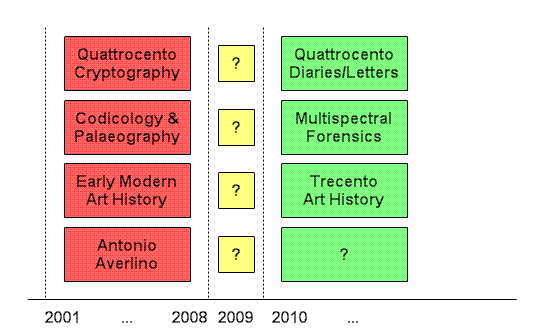I’ve had a number of off-blog posts, all commiserating with my apparent Voynich research burnout. All very kind, thank you for your support – but it ain’t actually so. Rather, what has happened is that I’ve been facing up to the shape of Voynich research to come – a change of direction so huge that I simply can’t carry it all on my own shoulders.
How will you recognize this Voynich Research 2.0? Once you fully accept the VMs’ basic art history (that it was made sometime between 1450 and 1500), the logical conclusion is that we should stop looking in the easy-but-wrong places (1.0, red below) and start looking in the hard-but-right places (2.0, green below)…

The reasoning is simple: because the VMs is a mid-Quattrocento object, the right place to be looking for contemporary mentions is in Quattrocento diaries and letters circa 1450-1475, the right place to be looking for sources for the imagery and secrets in the VMs is in the Trecento (specifically the Florentine Trecento), while codicology and palaeography now need to give way to multispectral forensic evidence. As for “whodunit”, I still think that it will turn out to be Antonio Averlino (as per my efforts within the Voynich Research 1.0 paradigm), but it will take a whole new kind of concerted search to uncover the full story behind the VMs.
My prediction is that 2009 will be the year when Voynich researchers will start to make the transition over to Voynich 2.0 thinking (and a whole lot of academics will join the party too), while by 2010 the whole 1.0 paradigm will be lost on the fringes.
So, what’s it to be? Where are you headed next?
At first glance it looks good! I agree that it will be harder. Also, I wouldn’t write off paleographic analysis. The problem there is that we haven’t got anyone who’s genuinely qualified to look at it. That where the academics at the party could really help.
As to multispectral forensics, could we do any of that with the images we’ve got, or would it all have to be done at the Beinecke?
Finally, I think some work with an honest cryptographic hypothesis would be worthwhile. My hypothesis at the moment is that the Voynichese system is a nomenclator, where the prefixes, stems, and suffixes are the coordinates in the nomenclator, and that some sort of word or phrase transposition is then made of the resulting nomenclator “words,” thus giving the line structure and word pair permutation analysis statistics we see.
Hi Dennis,
At its strongest, palaeography gets us (following Sergio Toresella) to 1460-1470 in Milan, and all the 15th century quire numbers are prima facie palaeographic evidence too – but this is basically as far as this kind of evidence can carry us, and we need to go further.
I’ve done what I can with the Beinecke’s scans, but once again we need to go further. Even a multispectral scan of the (apparently emended) marginalia would be a good start, particularly the original back page text.
As for your cryptographic hypothesis: it’s perfectly sensible, but I think that if we can nail the history, a lot of the unknowns will disappear from the equation.
Cheers, ….Nick P….
Hi Nick! I should have been clearer about palaeography. I meant that it would give us much-needed insight into what does and does not constitute a character/grapheme/glypheme. A truly expert palaeographer could tell us which strokes likely do and do not connect to form a glypheme; s/he could also comment on your idea on the length and position of tails being significant or not. Such things had precedents, and in some cases were codified during the time period in question, so we wouldn’t have to rely as much on statistics and outright speculation. Once again, this is where an academic could really help.
Currently, I would predict that even a very good palaeographer would have little better idea about the age of the script and the internal connectivity of the strokes than we already do. What I think would instead be useful would be something approaching forensic palaeography: a dissection of each letter in terms of the stroke directions and pressure, particularly for the various Currier hands. I’d like to know what kind of quill was used (eagle?), at what speed the text was written (brisk, not breakneck?), what physical size the author’s hand was (medium sized?), and perhaps even the author’s age: but, as I understand it, these are all on the forensic borders of palaeography. Note that I’m not talking about “graphology” per se, but rather what we can learn from the forensic physicality of the handwriting.
Can you see the kind of shift over from palaeographic extent (Voynich 1.0) to forensic intent (Voynich 2.0) I’m talking about?